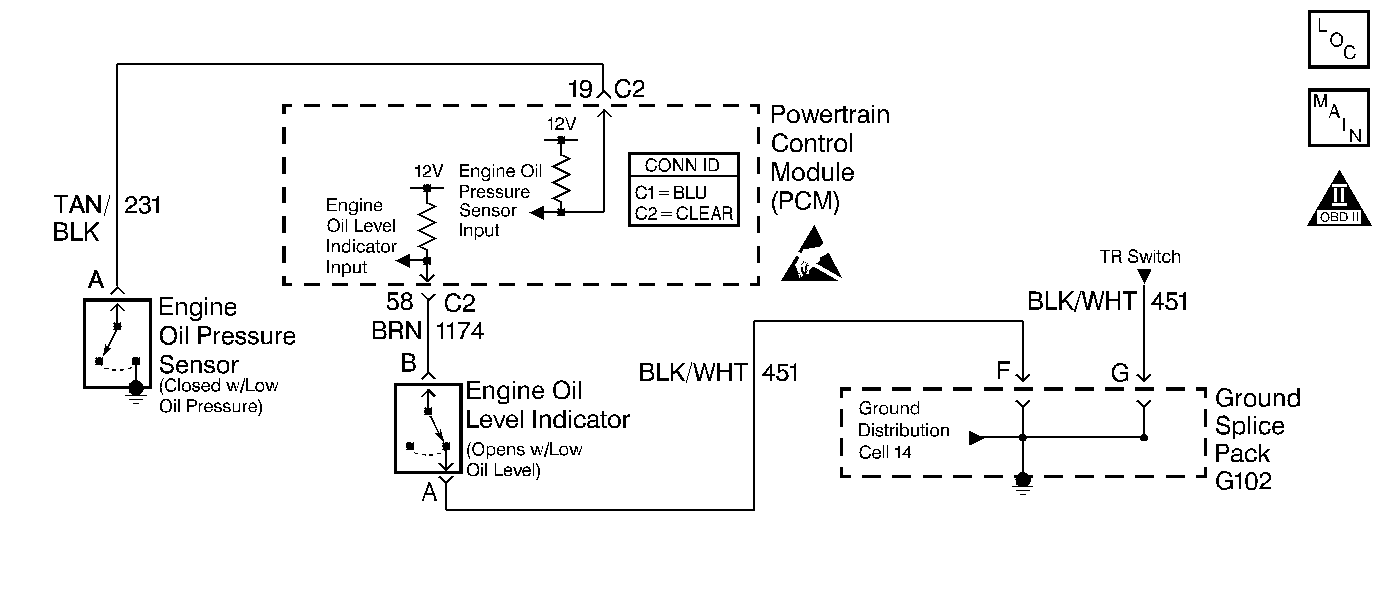
Circuit Description
The Engine Oil Level Switch is a simple float switch that is grounded when the engine oil level is OK. The PCM checks the Engine Oil Level switch circuit at startup. Before checking the state of the Engine Oil Level switch, the PCM performs a test routine based on time and engine coolant temperature to ensure that the engine oil has drained back into the sump. To test for low oil level at start-up, one of the following conditions must be present:
| • | The engine coolant temperature must be greater than 15°C (59°F). |
| • | The engine coolant temperature at key on must be at least 12°C (22°F) cooler than the engine coolant temperature at the last key off. |
The Low Oil Level Lamp will be illuminated for about a minute when the PCM checks for low oil level and the Engine Oil Level switch indicates that a low oil level condition exists (Engine Oil Level switch circuit not grounded). When the ignition is first turned on, the IPC commands the Low Oil Level lamp on for a brief period of time to test the bulb.
Diagnostic Aids
For diagnosis of the instrument panel, perform the System Check in the Instrument Cluster section of Electrical Diagnosis.
Check for the following conditions:
| • | Poor connection at PCM or oil level sensor. Inspect harness connectors for backed out terminals, improper mating, broken locks, improperly formed or damaged terminals, and poor terminal to wire connection. Refer to Intermittents and Poor Connections Diagnosis , Connector Repairs and Wiring Repairs in Wiring Systems. |
| • | Damaged harness. Inspect the wiring harness for damage. If the harness appears to be OK, disconnect the PCM and turn the ignition on. Observe a voltmeter connected to the affected PCM output circuit while moving connectors and wiring harnesses related to the PCM output circuit. A change in voltage will indicate the location of the fault. Refer to Intermittents and Poor Connections Diagnosis , Connector Repairs and Wiring Repairs in Wiring Systems. |
Test Description
Number(s) below refer to the step number(s) on the Diagnostic Table:
-
This vehicle is equipped with a PCM which utilizes an Electrically Erasable Programmable Read Only Memory (EEPROM). When the PCM is being replaced, the new PCM must be programmed.
-
For the PCM to check engine oil level, start-up engine coolant temperature must be at least 12°C (22°F) cooler than the engine coolant temperature was last time the ignition was turned off. Allowing the engine to warm and then cool ensures that the PCM checks the engine oil level switch and that the information displayed on the scan tool is current.
Step | Action | Value(s) | Yes | No |
|---|---|---|---|---|
1 |
Important: : Ensure that engine oil level is not low (as indicated on dipstick) before continuing diagnosis. Was the on Board Diagnostic (OBD) System Check performed? | -- | ||
2 | Observe Oil Level display on the scan tool. Does Oil Level display OK? | -- | ||
3 |
Is the testlamp on? | -- | ||
4 |
Does the DMM display voltage near the specified value? | B+ | ||
5 | Connect the DMM between the Oil Level Switch signal circuit and chassis ground. Does the DMM display a voltage near the specified value? | B+ | ||
6 |
Was a problem found? | -- | Go to Diagnostic Aids | |
7 |
Was a problem found? | -- | ||
8 |
Was a problem found? | -- | ||
9 | Locate and repair open in the Oil Level Switch ground circuit. Refer to Wiring Repairs in Wiring Systems. Is the action complete? | -- | -- | |
10 | Replace the Oil Level Switch. Is the action complete? | -- | -- | |
Replace the PCM. Important: : Replacement PCM must be programmed. Refer to Powertrain Control Module Replacement/Programming . Is the action complete? | -- | -- | ||
12 |
Does Oil Level display OK? | -- | System OK |
